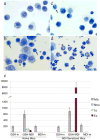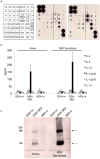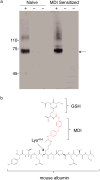Glutathione reaction products with a chemical allergen, methylene-diphenyl diisocyanate, stimulate alternative macrophage activation and eosinophilic airway inflammation
- PMID: 25635619
- PMCID: PMC4667722
- DOI: 10.1021/tx5005002
Glutathione reaction products with a chemical allergen, methylene-diphenyl diisocyanate, stimulate alternative macrophage activation and eosinophilic airway inflammation
Abstract
Isocyanates have been a leading chemical cause of occupational asthma since their utility for generating polyurethane was first recognized over 60 years ago, yet the mechanisms of isocyanate asthma pathogenesis remain unclear. The present study provides in vivo evidence that a GSH mediated pathway underlies asthma-like eosinophilic inflammatory responses to respiratory tract isocyanate exposure. In naïve mice, a mixture of GSH reaction products with the chemical allergen, methylene-diphenyl diisocyanate (MDI), induced innate immune responses, characterized by significantly increased airway levels of Chitinase YM-1 and IL-12/IL-23β (but not α) subunit. However, in mice immunologically sensitized to MDI via prior skin exposure, identical GSH-MDI doses induced substantially greater inflammatory responses, including significantly increased airway eosinophil numbers and mucus production, along with IL-12/IL-23β, chitinases, and other indicators of alternative macrophage activation. The "self"-protein albumin in mouse airway fluid was uniquely modified by GSH-MDI at position (414)K, a preferred site of MDI reactivity on human albumin. The (414)K-MDI conjugation appears to covalently cross-link GSH to albumin via GSH's NH2-terminus, a unique conformation possibly resulting from cyclized mono(GSH)-MDI or asymmetric (S,N'-linked) bis(GSH)-MDI conjugates. Together, the data support a possible thiol mediated transcarbamoylating mechanism linking MDI exposure to pathogenic eosinophilic inflammatory responses.
Figures





Similar articles
-
Connecting glutathione with immune responses to occupational methylene diphenyl diisocyanate exposure.Chem Biol Interact. 2013 Sep 5;205(1):38-45. doi: 10.1016/j.cbi.2013.06.005. Epub 2013 Jun 20. Chem Biol Interact. 2013. PMID: 23791970 Free PMC article.
-
Immune sensitization to methylene diphenyl diisocyanate (MDI) resulting from skin exposure: albumin as a carrier protein connecting skin exposure to subsequent respiratory responses.J Occup Med Toxicol. 2011 Mar 17;6:6. doi: 10.1186/1745-6673-6-6. J Occup Med Toxicol. 2011. PMID: 21414210 Free PMC article.
-
Toluene diisocyanate and methylene diphenyl diisocyanate: asthmatic response and cross-reactivity in a mouse model.Arch Toxicol. 2016 Jul;90(7):1709-17. doi: 10.1007/s00204-015-1606-6. Epub 2015 Oct 14. Arch Toxicol. 2016. PMID: 26468151
-
Occupational asthma after exposure to plaster casts containing methylene diphenyl diisocyanate.Occup Med (Lond). 2004 Sep;54(6):432-4. doi: 10.1093/occmed/kqg133. Occup Med (Lond). 2004. PMID: 15358843 Review.
-
Carcinogenic risk of toluene diisocyanate and 4,4'-methylenediphenyl diisocyanate: epidemiological and experimental evidence.Crit Rev Toxicol. 2001 Nov;31(6):737-72. doi: 10.1080/20014091111974. Crit Rev Toxicol. 2001. PMID: 11763481 Review.
Cited by
-
Acute 4,4'-Methylene Diphenyl Diisocyanate Exposure-Mediated Downregulation of miR-206-3p and miR-381-3p Activates Inducible Nitric Oxide Synthase Transcription by Targeting Calcineurin/NFAT Signaling in Macrophages.Toxicol Sci. 2020 Jan 1;173(1):100-113. doi: 10.1093/toxsci/kfz215. Toxicol Sci. 2020. PMID: 31609387 Free PMC article.
-
Mass spectrometry-based analysis of murine bronchoalveolar lavage fluid following respiratory exposure to 4,4'-methylene diphenyl diisocyanate aerosol.Xenobiotica. 2018 Jun;48(6):626-636. doi: 10.1080/00498254.2017.1344791. Epub 2017 Jul 21. Xenobiotica. 2018. PMID: 28629263 Free PMC article.
-
Reaction products of hexamethylene diisocyanate vapors with "self" molecules in the airways of rabbits exposed via tracheostomy.Xenobiotica. 2018 May;48(5):488-497. doi: 10.1080/00498254.2017.1329569. Epub 2017 Jun 1. Xenobiotica. 2018. PMID: 28489470 Free PMC article.
-
Immunochemical detection of the occupational allergen, methylene diphenyl diisocyanate (MDI), in situ.J Immunol Methods. 2016 Feb;429:60-5. doi: 10.1016/j.jim.2015.12.008. Epub 2015 Dec 12. J Immunol Methods. 2016. PMID: 26690039 Free PMC article.
-
Lung Gene Expression Suggests Roles for Interferon-Stimulated Genes and Adenosine Deaminase Acting against RNA-1 in Pathologic Responses to Diisocyanate.Chem Res Toxicol. 2024 Mar 18;37(3):476-485. doi: 10.1021/acs.chemrestox.3c00325. Epub 2024 Mar 4. Chem Res Toxicol. 2024. PMID: 38494904 Free PMC article.
References
-
- Allport DC, Gilbert DS, Outterside SM. MDI and TDI: Safety, Health and the Environment: A Source Book and Practical Guide. Wiley; Chichester: 2003. pp. 1–438.
-
- Fuchs S, Valade P. Clinical and experimental study of some cases of poisoning by Desmodur T (1-2-4 and 1–2-6 di-isocyanates of toluene) Arch Mal Prof. 1951;12:191–196. - PubMed
-
- Lesage J, Stanley J, Karoly WJ, Lichtenberg FW. Airborne methylene diphenyl diisocyanate (MDI) concentrations associated with the application of polyurethane spray foam in residential construction. J Occup Environ Hyg. 2007;4:145–155. - PubMed
-
- Kenyon NJ, Morrissey BM, Schivo M, Albertson TE. Occupational asthma. Clin Rev Allergy Immunol. 2012;43:3–13. - PubMed
Publication types
MeSH terms
Substances
Grants and funding
LinkOut - more resources
Full Text Sources
Other Literature Sources
Molecular Biology Databases
Miscellaneous

